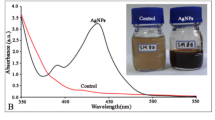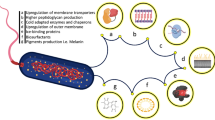Abstract
Light induces the formation of pycnidia inPhomopsis mali. The induction caused by light can be conserved in darkness. The size and quantity of pycnidia vary with the illuminance. Under low and high illuminances physiologically different pycnidia appear.Phomopsis mali cultivated in darkness in the presence of other microorganisms (fungi or bacteria) can fructify and produces pycnidia similar to those formed under low illuminance and in natural conditions. Our experiments indicate the presence of a pycnogenesis-inducing substance that can exists in different forms and induces the formation of the different pycnidia.
Abstract
Světlo indukovalo tvorbu pyknidií uPhomopsis mali. Tato indukce se udržovala i ve tmě. Podle intensity světla se měnil tvar a množství pyknidií i jejich fyziologické vlastnosti. Při kultivaci ve tmě v přítomnosti jiných mikroorganismů (hub nebo bakterií)Phomopsis mali vytvářela pyknidie podobné jako při nízkém osvětlení. Pokusy prokázaly existenci různých faktorů indukujících tvorbu pyknydií, a to pyknidií různého charakteru.
Similar content being viewed by others
Bibliographie
Calpouzos, L., Lapis, D. B.: Effects of light on pycnidium formation, sporulation and tropism bySeptoria nodorum.—Phytopathology60: 791–794, 1970.
Carlile, M. J.: The photobiology of fungi.—Annu. Rev. Plant Physiol.16: 175–202, 1965.
Cook, B. M., Gareth Jones D.: The effect of near ultraviolet irradiation and agar medium on the sporulation ofSeptoria nodorum andSeptoria tritici.—Trans. Brit. mycol. Soc.54: 221–226, 1970.
Emmanouilidis, I.: Induction de la formation des pycnides et des spores chezTrichoseptoria fructigena Maubl en milieu de culture artificielle.—Bull. Soc. Mycoll. France86: 269–275, 1970.
Joly, P.: Recherches sur les genresAlternaria etStemphylium. III, Action de la lumière et des Ultraviolets.—Rev. Mycol.22: 1–16, 1962.
Langeron, M., Vanbereuseghem, P. Précis de Mycologie.—Masson Ed., Paris 1952.
Leach, C. M.: Sporulation of diverse species of fungi under near ultra-violet radiation.—Can. J. Bot.40: 151–161, 1962 (a).
Leach, C. M.: The quantitative and qualitative relationship of ultra-violet and visible radiation to the induction of reproduction inAscochyta pisi.—Can. J. Bot.40: 1577–1602, 1962 (b).
Leach, C. M.: The qualitative and quantitative relationship of monochromatic radiation to sexual and asexual reproduction ofPleospora herbarum.—Mycologia55: 151–153, 1963.
Leach, C. M.: The relationship of visible and ultra-violet light to sporulation ofAlternaria chrysanthemi.—Trans. Brit. mycol. Soc.47: 333–344, 1964.
Leach, C. M.: An action spectrum for light inhibition of the “terminal phase” of photosporogenesis in the fungusStemphylium botryosum.—Mycologia60: 532–546, 1968.
Neergaard, P.: Detection of seed-borne pathogens, Lecture Notes.—Institut of seed pathology for developing countries, Copenhagen, 1971.
Onesirosan, P. T., Banttari, E. E.: The effect of light and temperature upon sporulation ofHelminthosporium teres in culture.—Phytopathology59: 906–909, 1969.
Richards, G. S.: Factors influencing sporulation bySeptoria nodorum.—Phytopathology41: 571–578, 1951.
Stevens, F. L.: Effects of ultra-violet radiation of varius fungi.—Bot. Gaz.86: 210–225, 1928.
Trione, E. J., Leach, C. M., Mutch, J. T.: Sporogenic substances isolated from fungi.—Nature212: 163–164, 1966.
Trione, E. J., Leach, C. M.: Light-induced sporulation and sporogenic substances in fungi.— Phytopathology59: 1077–1083, 1969.
Vargas, J. M., Jr.,Wilcoxson, R. D.: Some effects of temperature and radiation on sporulation byHelminthosporium dictyoides on agar media.—Phytopathology59: 1706–1712, 1969.
Zimmer, R. C., McKeen, W. E.: Interaction of light and temperature on sporulation of the carrot foliage pathogenAlternaria dauci.—Phytopathology59: 743–749, 1969.
Author information
Authors and Affiliations
Rights and permissions
About this article
Cite this article
Emmanouilidis, I., Cornic, G. Étude de la pycnogenèse chezPhomopsis mali (Schultz etSacc.)Rob. . Biol Plant 16, 50–56 (1974). https://doi.org/10.1007/BF02920820
Received:
Published:
Issue Date:
DOI: https://doi.org/10.1007/BF02920820




